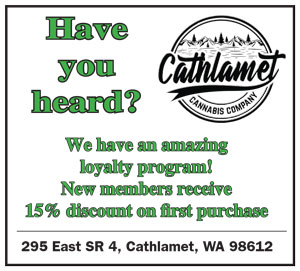Robots milk cows
July 27, 2017
Submitted by Jessica Vik and Ron Wright
Photo by Jessica Vik
When you think of dairy farming, you think of making hay, stinky air, milking cows, but how about robots? That's right! Gary and Susan Burk-halter installed two robotic milking machines three and a half years ago and the Wahkiakum 4-H Robotics Club went last weekend to check them out. "I've got to see it to believe it," mentor Ron Wright said. "I grew up on my grandfather's farm and I just don't believe it. Cows don't milk themselves."
Grays River Holsteins was started by Gary's parents in 1976. His wife Susan and he took over the business in 1994 and in 2006 they went organic with 500 acres of certified organic land. Then out of the difficulty of finding good reliable employees to milk the cows, they switched to robotic milking. Farming catalogs show the latest and greatest equipment for sale so they were aware of the robots. When they found out that a dairy in Tillimook, Oregon had installed the first robotic milker on the West coast, they went on their own field trip to check it out and the rest is history.
Gary, Susan and their second son Austin were great with the kids as they explained to them how everything worked. The LELY brand of robot took between two-three weeks to be set up and running smoothly. This included training each cow! Each robot can milk 60 cows, six minutes average per milking, and it operates 24 hours a day. The cows wear a collar with a chip that is scanned at the gate where they get their grain and are milked. Each cow's database algorithm is programmed for the proper amount of feed while milking. This is what keeps them coming back to get milked. If they come too often the robot's door will not open for them and off they go. Once inside there is a 3D camera with three camera views: left, front and back to help get things lined up. If either the gate sensor or the 3D camera are not working right, milking is shut down, and the farmer is alerted to come problem solve with a call to his cell phone. This was a great connection for our kids with their own small robots. They work with sensors also and when they are not working right, the program will run until that sensor needs to do its job. If something is wrong, it will not continue and you are shut down until adjustments are made.
A robot is only as smart as it is programmed. Their computer tracks the cows throughout the farm using radio collars. The Burkhalters know how the entire herd is doing and how each cow is doing. This is all checked in a 15 minute scan of the computer monitor every morning. The computer operating the robots uses a form of artificial intelligence: for example, it records each day how cows teats are changing in small ways so it can predict and adjust placement of the milking cups the next day. However, robots are not able to think out of the box. For example: bad teat placement on an udder or coming in with an extra muddy udder can foul things up. On the other hand, this freedom allows the Burkhalter family to enjoy Christmas without milking cows and had two steady milkers working around the clock and on Sundays. Even the electricity bill went down!
This was an expensive business move for this family farm but seems to have been a good one. They are only making slightly more money than before robotics, but their quality of life has improved dramatically. They no longer have to get up at 4:00 a.m., every day, and be back again at 4:00 p.m., all to milk the cows. They work about 10 hours per day, instead of the 16 hours per day before they installed the robots. This leaves more time to accomplish other work around the farm, improving their own productivity. Gary said, "Before, I would be sitting there milking cows and thinking about all of the chores I had to get done, and those I only wish I had time to do, and trying to decide which ones I would have to skip today. Now, I take care of the chores, and then keep on working on projects to improve our farm, knowing that the robot milkers are taking good care of our cows and will let me know if something isn't right." Just like we saw on our field trips to Wauna Paper Mill, Boeing Everett, and others, robots take over the repetitive tasks on a cost-competitive basis freeing humans to do more creative tasks. They create more jobs, not fewer, though the nature of the jobs change. The new jobs are in robotics, maintenance, engineering and programming. The students in Wahkiakum School District robotics classes and after school in 4-H are learning the robotics skills that apply to any field of work: coding, computers, sensors and motors. Its exactly the same in the real world as in class: just more complex and higher precision as the task gets more real.
There is a difference between all of the other robotics facilities we have visited so far and this one: forklifts and milling machines don't have feelings, cows do. The Burkhalters have also installed automatic back-scratching machines because happy cows produce more and better milk. While there we saw several cows go through, but one was especially fun to watch. She had figured out how to not only get her back scratched, but also to use the robot to scratch her neck and under her chin. She looked just like a cat with a big smile on her face. "I expected to hear her purring any moment," said Wright.
Speaking of our doubting mentor, Wright was heard to say as he stared slack-jawed at a cow happily munching away and being milked, "I see it, so I have to believe it. My grandfather would not have thought this possible."








Reader Comments(0)